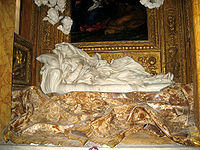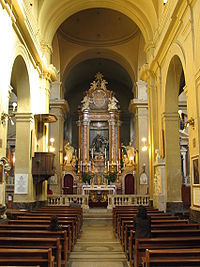
San Francesco a Ripa
Encyclopedia


Churches of Rome
There are more than 900 churches in Rome. Most, but not all, of these are Roman Catholic, with some notable Roman Catholic Marian churches.The first churches of Rome originated in places where Christians met. They were divided into three categories:...
, Italy. It is dedicated to Francis of Assisi
Francis of Assisi
Saint Francis of Assisi was an Italian Catholic friar and preacher. He founded the men's Franciscan Order, the women’s Order of St. Clare, and the lay Third Order of Saint Francis. St...
because the adjacent convent accommodated him, while the term Ripa refers to the nearby river-edge of the Tiber
Tiber
The Tiber is the third-longest river in Italy, rising in the Apennine Mountains in Emilia-Romagna and flowing through Umbria and Lazio to the Tyrrhenian Sea. It drains a basin estimated at...
.
History
The origins of this church are related to FranciscanFranciscan
Most Franciscans are members of Roman Catholic religious orders founded by Saint Francis of Assisi. Besides Roman Catholic communities, there are also Old Catholic, Anglican, Lutheran, ecumenical and Non-denominational Franciscan communities....
convent existing in the Trastevere
Trastevere
Trastevere is rione XIII of Rome, on the west bank of the Tiber, south of Vatican City. Its name comes from the Latin trans Tiberim, meaning literally "beyond the Tiber". The correct pronunciation is "tras-TEH-ve-ray", with the accent on the second syllable. Its logo is a golden head of a lion on a...
quarter of Rome since the 12th centuries. This had an annexed 1231 church dedicated to Saint Blaise
Saint Blaise
Saint Blaise was a physician, and bishop of Sebastea . According to his Acta Sanctorum, he was martyred by being beaten, attacked with iron carding combs, and beheaded...
(San Biagio). This church was decorated with the (now lost) St Francis cycle by Pietro Cavallini
Pietro Cavallini
Pietro Cavallini was an Italian painter and mosaic designer working during the late Middle Ages. Little is known about his biography, though it is known he was from Rome, since he signed pictor romanus....
. This cycle probably served as prototype for the famous Legend of St Francis frescoes, ascribed to Giotto di Bondone
Giotto di Bondone
Giotto di Bondone , better known simply as Giotto, was an Italian painter and architect from Florence in the late Middle Ages...
, in the Upper Basilica of St Francis
Basilica of San Francesco d'Assisi
The Papal Basilica of St. Francis of Assisi is the mother church of the Roman Catholic Order of Friars Minor—commonly known as the Franciscan Order—in Assisi, Italy, the city where St. Francis was born and died. The basilica is one of the most important places of Christian pilgrimage in Italy...
in Assisi.
Art and architecture
The construction of the present church was begun in 1603 by Onorio LonghiOnorio Longhi
Onorio Longhi was an Italian architect, the father of Martino Longhi the Younger and the son of Martino Longhi the Elder.Born in Viggiù, Lombardy, Longhi began as assistant for his father, and inherited the latter's commission at his death in 1591...
, starting from the apse
Apse
In architecture, the apse is a semicircular recess covered with a hemispherical vault or semi-dome...
. The facade
Facade
A facade or façade is generally one exterior side of a building, usually, but not always, the front. The word comes from the French language, literally meaning "frontage" or "face"....
was finished in 1681-1701 with design by Mattia de Rossi
Mattia de Rossi
Mattia de Rossi was an Italian architect of the Baroque period, active mainly in Rome and surrounding towns.Born in Rome to a family of architects and artisans, he rose to prominence under the mentorship of Gian Lorenzo Bernini, and even inherited the position as chief architect of the Fabbrica di...
. From 1873 to 1943 the church was used as barracks by the Bersaglieri
Bersaglieri
The Bersaglieri are a corps of the Italian Army originally created by General Alessandro La Marmora on 18 June 1836 to serve in the Piedmontese Army, later to become the Royal Italian Army...
.
In the first chapel of the right, there are frescoes by Fra Emanuele da Como and monument to cardinal Michelangelo Ricci by Domenico Guidi
Domenico Guidi
Domenico Guidi was a prominent Italian Baroque sculptor.Born in Carrara, Guidi followed his uncle, the prominent sculptor, Giuliano Finelli to Naples. As the nephew of a sculptor noted for his feud with Bernini, it is not surprising that Guidi was never employed by the eminent master...
. In second, Domenico Maria Muratori
Domenico Maria Muratori
Domenico Maria Muratori was an Italian painter.Muratori was a Bolognese painter who studied under Lorenzo Pasinelli. He had a daughter Teresa Scannabecchi who also became a painter. Muratori specialized in religious-themed works. He produced frescoes for the second chapel of San Francesco a Ripa....
frescoed events from the life of ‘’San Giovanni from Capestrano’’ (1725). In the third chapel, is an altarpiece (1685) by Stefano Maria Legnani
Stefano Maria Legnani
Stefano Maria Legnani , also known as "Legnanino", was an Italian painter of the Baroque period, active mainly in Milan. He was a pupil of his father, the painter Ambrogio Legnani. He then went on to work in the studio of Carlo Cignani in Bologna, and Carlo Maratta in Rome. In Novara, he painted...
. In the transept is the chapel of the Rospigliosi-Pallavicini, started by Nicolas Michetti and completed by Ludovico Rusconi in 1725. Inside the altarpiece depicts San Pietro d' Alcantara and San Pasquale Babylon painted by Tommaso Chiaro and the funeral monuments of Stefano and Lazzaro Pallavicini, Maria Camilla, and Giambattista Rospigliosi based on designs of Michetti. The main altar was completed in 1746. The Saint Francis is attributed to Fra Diego da Careri, the Trinity canvas by Paris Nogari
Paris Nogari
Paris Nogari was an Italian painter of the Renaissance period, a minor pupil of Cesare Nebbia active mainly in Rome. He painted in the library of the Vatican in a style resembling Raffaellino da Reggio and was among the painters who frescoed Santa Susanna.-References:...
.
In the left transept, the chapel Paluzzi-Albertoni designed by Giacomo Mola 1622-1625. Inside is one of Bernini’s masterpieces, the statue of the Blessed Ludovica Albertoni
Ludovica Albertoni
Ludovica Albertoni , sometimes known as Louisa Albertoni or Ludovica Albertoni Cetera, is considered a blessed person in Christianity. Her feast day is January 31....
(1671-1675). This sculpture readily recalls the recumbent Santa Teresa in Ecstasis. Behind the statue is a painting of Saint Anna and the Virgin by Giovanni Battista Gaulli
Giovanni Battista Gaulli
Giovanni Battista Gaulli , also known as Baciccio, Il Baciccio or Baciccia , was a painter of the Italian High Baroque verging onto that of the Rococo...
. In third chapel on the left is a bust of Laura Frangipani sculpted by Andrea Bolgi
Andrea Bolgi
Andrea Bolgi was an Italian sculptor responsible for several statues in St. Peter's Basilica, Rome. Towards the end of his life he moved to Naples, where he sculpted portrait busts.-Early life:...
(1637), on the forehead wall bust by the Orazio Mattei attributed to Lorenzo Ottoni
Lorenzo Ottoni
Lorenzo Ottoni was an Italian sculptor who was commissioned by the papacy and various noble houses of renaissance Italy.-Life:Ottoni was born in Rome in 1658 and spent the majority of his life in the city....
. In the second chapel, frescoes by Giovanni Battista Ricci. To the center an Annunciation (1534) by Francesco Salviati
Francesco de' Rossi (Il Salviati)
Francesco de' Rossi was an Italian Mannerist painter from Florence, also active in Rome. He is known by many names, prominently the adopted name Francesco Salviati or as Il Salviati, but also Francesco Rossi and Cecchino del Salviati.-Biography:Salviati was born and died in Florence...
. The tomb of Giuseppe Paravicini was sculpted by Camillo Rusconi
Camillo Rusconi
Camillo Rusconi was an Italian sculptor of the late Baroque in Rome. His style displays both features of Baroque and Neoclassicism. He has been described as a Carlo Maratta in marble.-Biography:...
. In the first chapel, is a painting by Marten de Vos
Marten de Vos
Marten de Vos , also Maarten, was a leading Antwerp painter and draughtsman in the late sixteenth century.-Biography:Like Frans Floris, he travelled to Italy and adopted the mannerist style popular at the time. De Vos was also highly influenced by the colors of Venetian painting, and might have...
(1555), to right, an Assumption by Antonio della Cornia, on the left, a Birth of the Virgin (1620) by Simon Vouet
Simon Vouet
Simon Vouet was a French painter and draftsman, who today is perhaps best remembered for helping to introduce the Italian Baroque style of painting to France.-Life:...
.
Notable also is the copy alleged portrait of St. Francis by the friar Margaritone d'Arezzo
Margaritone d'Arezzo
Margarito or Margaritone d'Arezzo was an Italian painter from Arezzo.-Life:Little is known of Margaritone's life. The only documentary record of his existence dates from 1262, when he lived in Arezzo. However, a fair number of his works are known to survive; unusually for the time, most are signed...
: if confirmed, it would be the first true portrait of the history of Italian arts (the original is in the Pinacoteca Vaticana). The church houses also, in the cell where the saint lived, a black stone he had used as a cushion. In the garden of the convent is an orange
Orange (fruit)
An orange—specifically, the sweet orange—is the citrus Citrus × sinensis and its fruit. It is the most commonly grown tree fruit in the world....
tree, which according to the tradition was planted by the same Francis.
The square in front of the church has one Ionian column erected by Pope Pius IX
Pope Pius IX
Blessed Pope Pius IX , born Giovanni Maria Mastai-Ferretti, was the longest-reigning elected Pope in the history of the Catholic Church, serving from 16 June 1846 until his death, a period of nearly 32 years. During his pontificate, he convened the First Vatican Council in 1869, which decreed papal...
, taken from the ruins of Veii
Veii
Veii was, in ancient times, an important Etrurian city NNW of Rome, Italy; its site lies in Isola Farnese, a village of Municipio XX, an administrative subdivision of the comune of Rome in the Province of Rome...
.

